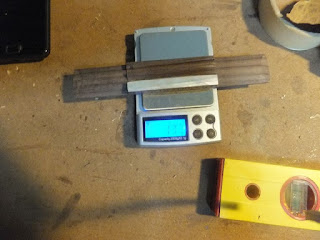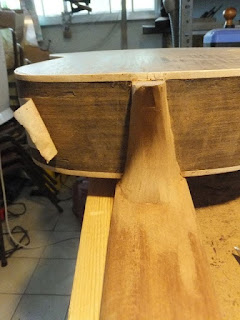20130214
I wanted to glue the lining but it was raining for the past few weeks, I had to do things which doesn't require gluing.
So I began to make the bridge.
I was wonder what bridge material to use, I had a few very good Madagascar Rosewood bridge blank which is light looks good and more importantly has a very glassy tap tone.
But in the end I choose a relatively OK tap tone Indian rosewood blank but is ultra light.
I intend to make this an all IRW guitar including using the IRW for fingerboard, so it makes sense to use IRW for the bridge too.
Furthermore I had this ultra light blank which makes a good candidate for the bridge.
I wanted to see if I can make it about 15g. :)
If I managed to do that, that will be my lightest bridge to date.
The blank wasn't aligned with the grain, but it's big enough to saw away the 2 edges and still have enough for the bridge.
So I saw away the 2 skew edges and leave the grain square to the bridge.
It's a rift sawn blank, looking from the sides so I have no worries the saddle will break at the grain line.
Anyway after sawing away the skew part, I plane the blank to size and mark the tie block region.
Next I use the scraper to scrape the bottom of the blank and check the fit to the top doming.
When it's almost fitted, I put a sand paper on the top and sand the bottom of the blank.

Weighing the blank.

Scraping the bottom of the blank

Checking the fit of the bridge blank with the top.

Sand the bottom of the bridge to the top
20130219
Next I routed the saddle slot and thin the wings.
Unfortunately at the last pass for the saddle slot, I push the dremel router base over the fence.
So I routed into the front saddle block by a bit.
Now I just have to plug it in.
I measure the weight is not at 20g, it would be easy to hit 17 when U thin the tie block further.

Cutting the kerf for the tie block

The saddle slot routing setup

Mistake when I route into the front saddle block. I push the router base over the fence

Both saddle slot and the space between the saddle block and tie block done.

Cutting kerf for the wing's excess removal

Chisel away the waste

Plane away the waste

Carve the rear saddle block with a slope

Weight is 20g. Target is min 17g and if possible 15g preferred
20130322
I glue a MOP onto the tieblock and shape the wings to correct thickness.
Final weight is 18g, well one short of my target.
Without the MOP it's 17g.
I still have to drill the string holes and plug in the mistake.

Gluing the MOP

Clamp it

Done. 18g

The bridge

Close up at the MOP inlay at the tie block. I have yet to polish it.
20130618
I patched the small blotch whe I route the saddle slot.
I just hold a small piece of IRW cut-off with a pliers, and chisel it into a cylinder.
Finally I sand to correct size and apply glue to stick it in.
After the glue is dried, I saw off the protruding part and chisel the extended part in the slot.
It looks good now.

The error patched by gluing a small cut-off onto it.

Cleaned up
20130625
The last part of the bridge making involves drilling the holes.
I use my last set up to drill the holes.
It work reasonably well for me.
The base holes were drilled perfectly but the 2 upper holes for the 18 hole bridge, weren't as nice...
I didn't adjust the height of the RTX properly before drilling the upper holes.
The weight of the bridge after drilling is 17.7g nice!
I can't really wait to glue on the bridge.

The setup for drilling bridge string holes.

Holes drilled. Base holes were nice but the upper holes is abit too low. I didn't adjust the height properly

Weight of the bridge is 17.7 after drilling





















































